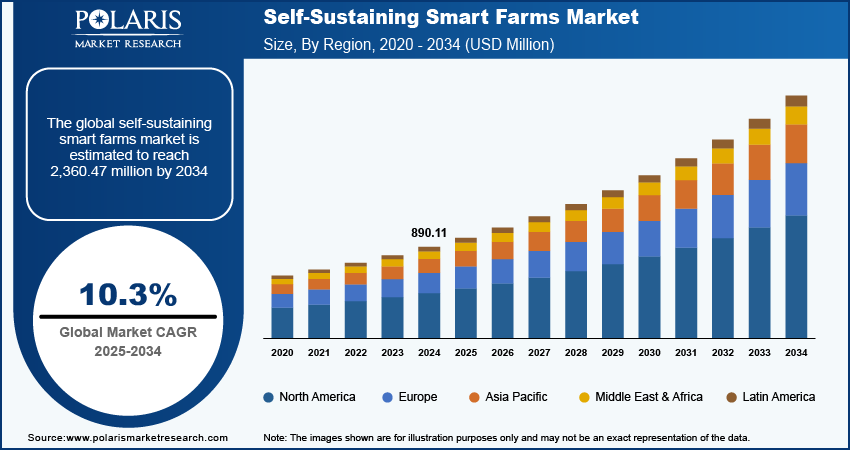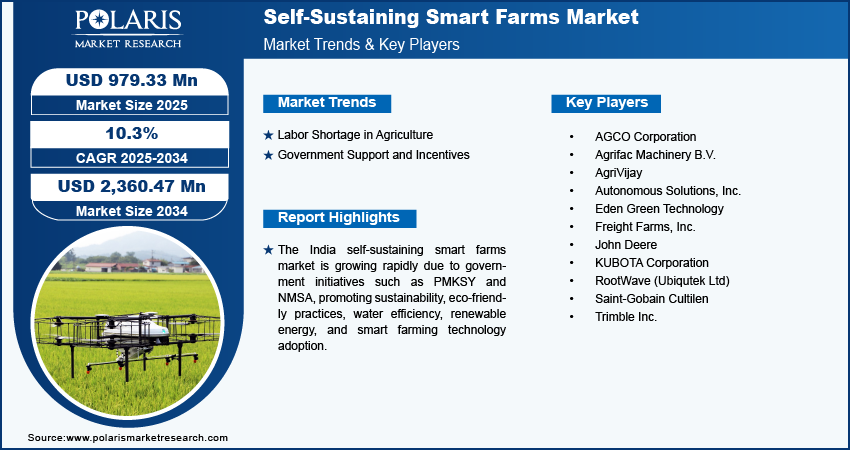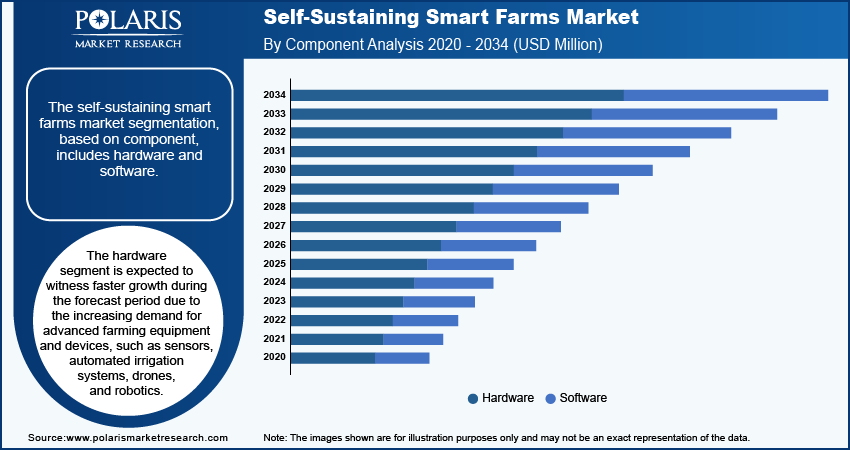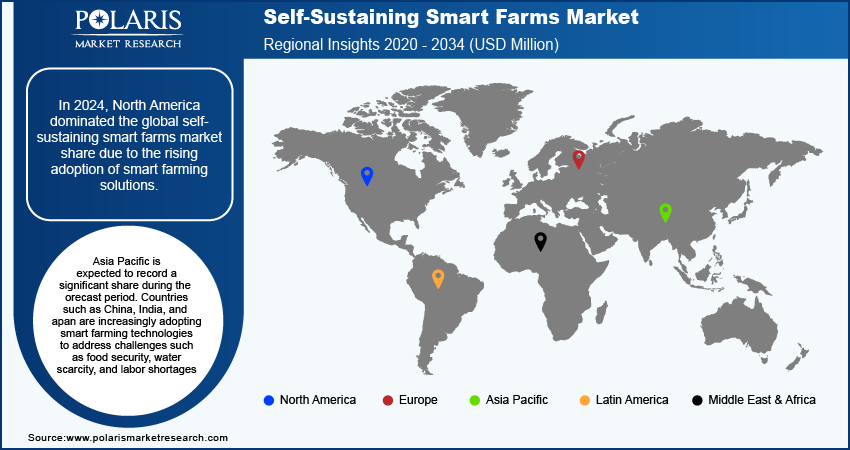
Self-Sustaining Smart Farms Market Size, Share, Trends, Industry Analysis Report: By Component (Software and Hardware), Farm Type, End User, and Region (North America, Europe, Asia Pacific, Latin America, and Middle East & Africa) – Market Forecast, 2025–2034
- Published Date:Mar-2025
- Pages: 125
- Format: PDF
- Report ID: PM5411
- Base Year: 2024
- Historical Data: 2020-2023
Self-Sustaining Smart Farms Market Overview
The global self-sustaining smart farms market size was valued at USD 890.11 million in 2024. The market is projected to grow from USD 979.33 million in 2025 to USD 2,360.47 million by 2034, exhibiting a CAGR of 10.3% during 2025–2034.
A self-sustaining smart farm uses various advanced technologies such as IoT, sensors, and automation to optimize farming processes, including irrigation, fertilization, and harvesting, reducing the need for manual intervention. It aims to minimize resource usage, improve crop yields, and operate in a sustainable, environmentally friendly manner.
The rise of Internet of Things (IoT) devices and automation has revolutionized farming. These technologies allow farmers to monitor soil moisture, temperature, and crop health in real time through sensors. Automated systems control irrigation, fertilization, and pest control without much manual effort. This saves time, reduces labor costs, and ensures farming is done more efficiently. The ability to gather and analyze data helps farmers make better decisions, leading to optimized farming practices. Improvements in these technologies have made smart farming more accessible and affordable to a wider range of farmers, thereby driving the self-sustaining smart farm market demand.

To Understand More About this Research: Request a Free Sample Report
Sustainability is becoming increasingly important in agriculture. Consumers and governments are demanding eco-friendly farming practices due to concerns over environmental issues such as climate change, soil depletion, and water scarcity. Self-sustaining smart farms use less water, reduce the need for harmful pesticides, and minimize waste. Sustainable farming practices ensure that farming continues to meet food demands without negatively impacting the environment. Growing concerns over environmental issues are pushing more farmers to adopt smart farming technologies to align with these demands, thereby boosting the self-sustaining smart farm market growth.
Self-Sustaining Smart Farms Market Dynamics
Labor Shortage in Agriculture
Many regions face a shortage of skilled labor in agriculture, making traditional farming practices difficult to sustain. For instance, according to the World Bank, in India alone, agriculture employment decreased to 44% in 2022 of the total population from 58% in 2002, showcasing the shortage of labors in agriculture sector. Farmers are increasingly turning to technology to bridge the gap. Automation and smart farming solutions perform essential tasks such as planting, harvesting, and irrigation without human labor. This shift reduces dependency on manual labor and increases farm productivity, thereby propelling the self-sustaining smart farm market development.
Government Support and Incentives
Governments across the world are increasingly recognizing the importance of sustainable agriculture and are offering support for technologies that promote it. Incentives, subsidies, and grants are available to farmers who adopt smart farming solutions. For instance, the Government of India launched the National Mission for Sustainable Agriculture (NMSA), in which USD 131.56 million in funds were provided as of 2024. These policies support farmers to afford new technologies and push them to follow environmentally friendly practices. Additionally, in some regions, governments are setting regulations to encourage the use of energy-efficient and resource-conserving technologies. Thus, government support and incentives for smart farming boost the self-sustaining smart farm market growth.

Self-Sustaining Smart Farms Market Segment Analysis
Self-Sustaining Smart Farms Market Assessment by Component Outlook
The self-sustaining smart farms market segmentation, based on component, includes hardware and software. The hardware segment is expected to witness faster growth during the forecast period. This growth is driven by the increasing demand for advanced farming equipment and devices, such as sensors, automated irrigation systems, drones, and robotics. These hardware components are essential for monitoring soil conditions, managing crops, and automating various farming tasks, all of which improve farm productivity and sustainability. The need for efficient, durable, and cost-effective hardware solutions rises as more farmers adopt smart farming technologies, leading to the segmental growth.
Self-Sustaining Smart Farms Market Evaluation by Farm Type Outlook
The self-sustaining smart farms market, based on farm type, is segmented into vertical farms, aquaponics farms, greenhouse-based smart farms, open-field smart farms, and others. The greenhouse-based smart farms segment dominated the self-sustaining smart farms market share in 2024. These farms utilize advanced technology to control environmental factors such as temperature, humidity, and light, ensuring optimal conditions for crop growth. They offer greater efficiency in water usage, pest control, and energy consumption, making them highly sustainable. The ability to grow crops throughout the year, regardless of weather conditions, further improves their appeal. This combination of sustainability and efficiency is driving the adoption of greenhouse-based smart farms, leading to their segmental dominance in the self-sustaining smart farm market.

Self-Sustaining Smart Farms Market Regional Analysis
By region, the study provides the self-sustaining smart farms market insights into North America, Europe, Asia Pacific, Latin America, and the Middle East & Africa. In 2024, North America dominated the global self-sustaining smart farms market revenue share. The region is home to players offering advanced agricultural technologies and focuses on sustainability, which is driving the adoption of smart farming solutions. Countries such as the US and Canada are investing heavily in automation, precision farming, and renewable energy solutions for agriculture. The rising demand for efficient food production and reducing environmental impact is driving the adoption of smart farming technologies, thereby driving the self-sustaining smart farm market expansion in North America.
Asia Pacific is expected to record a significant share of the market during the forecast period. Countries such as China, India, and Japan are increasingly adopting smart farming technologies to address challenges such as food security, water scarcity, and labor shortages. The region's large agricultural base and rising demand for efficient, sustainable farming practices are fueling the adoption of automated systems, sensors, and renewable energy solutions. Additionally, government initiatives and investments in agricultural technology are accelerating the growth of smart farms, thereby boosting the Asia Pacific self-sustaining smart farm market growth.
The India self-sustaining smart farms market is experiencing substantial growth fueled by government initiatives aimed at promoting sustainability. Programs such as the Pradhan Mantri Krishi Sinchayee Yojana (PMKSY) and the National Mission on Sustainable Agriculture (NMSA) support eco-friendly farming practices, encouraging water-efficient irrigation systems, renewable energy use, and organic farming methods. The government provides subsidies and financial aid to encourage the adoption of smart farming technologies. These efforts are helping transition traditional farming methods into smart farming and environmentally sustainable practices, driving the self-sustaining smart farms market growth in India.

Self-Sustaining Smart Farms Market – Key Players & Competitive Analysis Report
The self-sustaining smart farms market is constantly evolving, with numerous companies striving to innovate and distinguish themselves. Leading global corporations dominate the market by leveraging extensive research and development, and advanced techniques. These companies pursue strategic initiatives such as mergers and acquisitions, partnerships, and collaborations to enhance their product offerings and expand into new markets.
New companies are impacting the self-sustaining smart farms industry by introducing innovative products to meet the demand of specific sectors. This competitive environment is amplified by continuous progress in product offerings. A few major players in the self-sustaining smart farms market include Autonomous Solutions, Inc.; Agrifac Machinery B.V.; Saint-Gobain Cultilen; RootWave (Ubiqutek Ltd); Eden Green Technology; AgriVijay; Freight Farms, Inc.; John Deere; Trimble Inc; AGCO Corporation; and KUBOTA Corporation.
Trimble Inc., founded in 1978, is an American technology company providing software, hardware, and services that integrate the digital and physical worlds. Its core technologies encompass positioning, modeling, connectivity, and data analytics, with solutions aimed at improving productivity, quality, safety, transparency, and sustainability across various industries. The company's product range includes GNSS receivers, scanners, total stations, laser rangefinders, UAVs, and inertial navigation systems, alongside software processing tools available through subscription, term, and perpetual licenses. Trimble serves diverse sectors by offering tools to measure, build, grow, and move assets. A key area of focus is agriculture, where Trimble Agriculture provides precision solutions designed to address technological challenges throughout the agricultural supply chain. These solutions enable farmers to optimize resource allocation for a reliable and safe food supply while promoting environmental sustainability. The agriculture product line includes guidance and steering systems, flow and application controls, water management tools, planting solutions, nutrient management, and crop protection technologies. Trimble’s solutions are versatile, accommodating various seasons, crops, terrains, and farm sizes, and are compatible with equipment from most manufacturers. The Connected Farm concept represents Trimble’s intention to offer a suite of precision solutions for modern agricultural management. Operating globally, Trimble has a significant presence across numerous countries, including the US, Sweden, Germany, Finland, New Zealand, Canada, the Netherlands, China, the UK, and India.
Kubota Corporation, founded in 1890 and based in Osaka, Japan, operates as a multinational manufacturing and technology company. Publicly listed on the Tokyo Stock Exchange, Kubota's activities encompass agricultural machinery, construction equipment, engines, and environmental solutions. Originating as a foundry, Kubota expanded into agriculture with kerosene engines in 1922 and later contributed to 3D graphics chips and the Solar Ark project. The company's product line includes tractors; combine harvesters; construction equipment; engines ranging from 0.276-liter to 6.1-liter; vending machines; pipes; valves; cast metal; pumps; and systems for water purification, sewage treatment, and air conditioning. Kubota is involved in rice and dry-field farming, developing technologies and equipment to support food production. The company is also engaged in smart agriculture, integrating data and automation to improve farming practices. The Agri Robo series features automated tractors, combine harvesters, and transplanters for rice farming. The Kubota Smart Agri System (KSAS) employs technologies and ICT to support farm operations, visualizing agricultural data for management. Kubota maintains a global presence with manufacturing facilities in Japan, the USA, Germany, France, China, and Thailand. The company distributes its products across Europe, North America, Latin America, Oceania, Asia, and Africa. Kubota Tractor Corporation manages the distribution of Kubota products in the US. Kubota's activities in water and environment systems include ductile iron pipes, valves, pumps, and sewage treatment plants.
List of Key Companies in Self-Sustaining Smart Farms Market
- AGCO Corporation
- Agrifac Machinery B.V.
- AgriVijay
- Autonomous Solutions, Inc.
- Eden Green Technology
- Freight Farms, Inc.
- John Deere
- KUBOTA Corporation
- RootWave (Ubiqutek Ltd)
- Saint-Gobain Cultilen
- Trimble Inc.
Self-Sustaining Smart Farms Market Segmentation
By Component Outlook (Revenue USD Million, 2020–2034)
- Hardware
- Software
By Farm Type Outlook (Revenue USD Million, 2020–2034)
- Vertical Farms
- Aquaponics Farms
- Greenhouse-Based Smart Farms
- Open-Field Smart Farms
- Others
By End User Outlook (Revenue USD Million, 2020–2034)
- Agripreneurs
- Commercial Agriculture Enterprises
- Government
- Academic & Research Institute
- Others
By Regional Outlook (Revenue USD Million, 2020–2034)
- North America
- US
- Canada
- Europe
- Germany
- France
- UK
- Italy
- Spain
- Netherlands
- Russia
- Rest of Europe
- Asia Pacific
- China
- Japan
- India
- Malaysia
- South Korea
- Indonesia
- Australia
- Rest of Asia Pacific
- Middle East & Africa
- Saudi Arabia
- UAE
- Israel
- South Africa
- Rest of Middle East & Africa
- Latin America
- Mexico
- Brazil
- Argentina
- Rest of Latin America
Self-Sustaining Smart Farms Market Report Scope
|
Report Attributes |
Details |
|
Market Size Value in 2024 |
USD 890.11 million |
|
Market Size Value in 2025 |
USD 979.33 million |
|
Revenue Forecast by 2034 |
USD 2,360.47 million |
|
CAGR |
10.3% from 2025 to 2034 |
|
Base Year |
2024 |
|
Historical Data |
2020–2023 |
|
Forecast Period |
2025–2034 |
|
Quantitative Units |
Revenue in USD million and CAGR from 2025 to 2034 |
|
Report Coverage |
Revenue Forecast, Market Competitive Landscape, Growth Factors, and Trends |
|
Segments Covered |
|
|
Regional Scope |
|
|
Competitive Landscape |
|
|
Report Format |
|
|
Customization |
Report customization as per your requirements with respect to countries, regions, and segmentation. |
FAQ's
• The self-sustaining smart farms market size was valued at USD 890.11 million in 2024 and is projected to grow to USD 2,360.47 million by 2034.
• The global market is projected to register a CAGR of 10.3% during 2025–2034.
• North America held the largest share of the global market in 2024.
• A few key players in the market are Autonomous Solutions, Inc.; Agrifac Machinery B.V.; Saint-Gobain Cultilen; RootWave (Ubiqutek Ltd); Eden Green Technology; AgriVijay; Freight Farms, Inc.; John Deere; Trimble Inc; AGCO Corporation; and KUBOTA Corporation.
• The greenhouse-based smart farms segment dominated the market share in 2024, as it offers greater efficiency in water usage, pest control, and energy consumption, making them highly sustainable.
• The hardware segment is expected to witness faster growth during the forecast period due to the increasing demand for advanced farming equipment and devices, such as sensors, automated irrigation systems, drones, and robotics.
